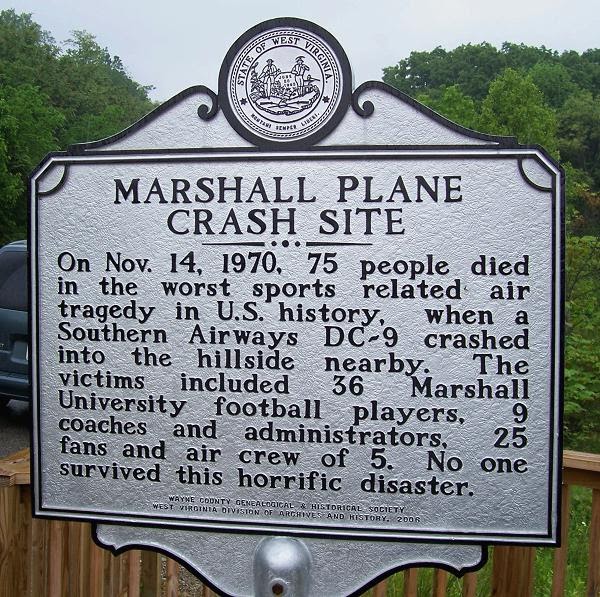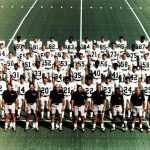College Football Air Tragedies Remembered 50 Years Later

A black pall was cast over college football not once, but twice in 1970.
The gloom began on Oct. 2 when one of two planes carrying members of the Wichita State University football team crashed into a Colorado mountain shortly after refueling on the way to Logan, Utah where the Shockers were scheduled to play Utah State the following day.
Tragedy struck again just over six weeks later when the entire Marshall football team, 35 players and eight coaches, along with 25 boosters, died when their plane crashed near Hungtington, W.V. after returning from a game at East Carolina.
Sadly, they were not the first air crashes involving college athletics. Nor were they the last.
Legendary Notre Dame football coach died on March 31, 1931 less than an hour after leaving Kansas City when one of the wings of his plane broke up in flight before crashing into a wheat field near Bazaar, Kansas. Rockne, who was 43, along with seven others died in the crash.
Nearly 70 years later two Oklahoma State basketball players and six other OSU broadcasters and coaches, along with both pilots died when their plane crashed 40 miles east of Denver during a snowstorm on Jan. 27, 2001.
WICHITA STATE
Wins and losses mean little in the grand scheme of things.
Wichita State learned that lesson in a big way in 1970 when one of two planes carrying members of the football team crashed shortly after refueling in Denver. The Shockers were scheduled to take on Utah State the following day in Logan, Utah.
The two planes, dubbed “Gold” and “Black” because of the school colors, arrived in Wichita from their base in Oklahoma City earlier on Oct. 2 and were loaded with luggage and the passengers. Gold, the plane that later crashed, carried the starting players, head coach and athletics director, as well as their wives, administrators, boosters and family. Black carried the reserve players, assistant coaches and other support personnel.
The pilot of Gold, Ronald G. Skipper, visited with the passengers in the cabin during the flight to Denver. He advised them that after refueling in the Mile High City the plane would take a scenic route near Loveland Ski Area and Mount Sniktau, the proposed alpine skiing venues for the 1976 Winter Olympics, which had recently been awarded to Denver.
The other plane adhered to its original flight plan and took a more northerly route from Denver to southern Wyoming then west. Considered less scenic, this designated airway reportedly allowed more time to gain altitude for the climb over the Rocky Mountains.
After being serviced and refueled at Denver’s Stapleton International Airport, Gold continued on its planned scenic course in clear weather. A short time later witnesses reported seeing an aircraft flying unusually low towards the Continental Divide. Some witnesses located on higher mountainside locations, such as Loveland Pass (11,990 feet elevation) reported seeing the plane flying below them.
“As we flew along Interstate 70, there were old mines and old vehicles above us,” said Rick Stephens, a senior guard who survived the crash. “I noticed we were quite a bit below the top of the mountains. I got up to go to the cockpit, which wasn’t unusual to do, and I could tell we were in trouble … looking out the window and seeing nothing but green in front of us.”
Shortly later the plane became trapped in a box canyon in Clear Creek Valley and was unable to climb above the surrounding mountain ridge and could not complete a turn away from the sharply rising terrain.
At 1:14 p.m. the plane struck trees on the east slope of Mount Trelease (1,600 elevation) and crashed.

The load of fuel on board did not explode immediately which allowed survivors to escape the wreckage. An explosion a short time later consumed the passenger cabin preventing those still alive and trapped inside from getting to safety.
Twenty-nine passengers died at the scene and two died later from injuries sustained in the crash. Fourteen of the casualties were WSU players. Head coach Ben Wilson, who was in his second season at WSU, along with his wife, Helen, were also killed in the crash.
Utah State’s football team held a memorial service the next day at the stadium where the game against the Shockers was to have been played and placed a wreath on the 50-yard line. Wichita State University officials and family members of the survivors were flown to Denver on an airplane made available by then-Kansas governor Robert Docking.
WSU cancelled classes for Oct. 5 and a memorial service was held that evening at Cessna Stadium. The NCAA and Missouri Valley Conference allowed the school to add freshman to fill out the squad after the team voted to continue the 1970 season. The remaining portion of the season was dubbed the “Second Season.”
A roadside memorial in located in Colorado along Interstate 70 at milepost 217 to honor the victims.
Wichita State built a memorial, called Memorial ’70, on campus and each year at 9 a.m. on Oct. 2, a wreath is placed at the memorial.
Wichita State had opened the 1970 season by losing its first three games prior to the tragedy in Colorado. The season resumed two weeks later when the Shockers played host to Cincinnati. The visitors won that game 35-5 and WSU went on to finish 0-9-0 on the year.
Wichita State and Utah State had played in five of the previous six seasons. The two schools would never meet again as Wichita State discontinued its football program after the 1986 season.

MARSHALL
As the college football world, and the nation, were still reeling from the tragedy surrounding Wichita State, disaster struck again just 43 days later on Nov. 14.
A Southern Airways chartered flight were returning to Huntington Tri-State Airport after Marshall’s 17-14 loss at East Carolina earlier in the day. On board were 37 players and eight coaches, including head coach Rick Tolley, along with 25 booster and five crew members. All 75 on board died in the crash, which remains the deadliest air crash involving a sports team in U.S. history.
All the victims were reportedly burned beyond recognition and the investigation that followed closed nearby roadways for hours. All incoming air traffic was also halted during the investigation.
At the time, Marshall rarely traveled by plane, since most away games were within easy driving distance of campus. The team had reportedly originally planned to cancel the flight, but changed those plans and chartered the DC-9 after a reduction of the weight of passengers and baggage.
The plane left Stallings Field in Kinston, N.C. following the game against the Pirates. The flight was without incident until shortly before the crash.
At 7:23 p.m. the crew established radio contact with air traffic controllers and were given instructions to descend to 5,000 feet. Despite rain, fog, smoke and a ragged ceiling in the area, which made for a more difficult, but possible landing, the crew passed the airport’s outer marker 11 minutes later and were given clearance to land.
Instead of holding its descent altitude at 1,240 feet, as required by the instrument approach procedure, the decent continued for 300 more feet for unknown reasons.
The plane crashed a short time later when it collided with the tops of trees on a hillside just over a mile west of the runway and burst into flames. The flames created a swath of charred ground 95 feet wide and 279 feet long in what the National Transportation Board later deemed “unsurvivable.”
The NTSB report also reported the aircraft had “dipped to the right, almost inverted and crashed into a hollow ‘nose-first.’”
One day after the disaster, a memorial service was held at Marshall’s Veterans Memorial Field House. One week later another memorial service was held at Fairfield Stadium. A mass funeral was held at the Field House and many of the victims were buried at the Spring Hill Cemetery. Some victims were buried together when six bodies were unable to be identified.
It was the only charter flight of the season for Marshall and with the large number of prominent local residents a part of the entourage, it is estimated that 70 children lost at least one parent in the disaster.
The loss to ECU earlier in the day dropped the Thundering Herd to 3-6 on the season. The disaster almost led to the school to decide to discontinue its football program.
Red Dawson, a receivers coach for the 1970 team, along with freshman coach Gail Parker, had been with the team in Greenville, but had been scheduled to embark on a recruiting visit following the game. The two were reportedly buying boiled peanuts at a country store in rural Virginia when they heard radio reports of the crash.
Dawson and Parker, along with new coach Jack Lengyel, students and fans, convinced them-school president Donald N. Dedmon to reconsider the decision to cancel the program.
The following year, with several players from the junior varsity team in 1970, along with students and athletes from other sports, many whom had never played football before, Marshall returned to football. The Thundering Herd returned to football on Sept. 18, 1971 in a 29-6 loss at Morehead State. The following week they played at home for the first time since the disaster and defeated Xavier (Ohio) 15-13. Marshall would end the 1971 season 2-8-0.
Two years after the crash the Memorial Fountain was dedicated at the entrance of the Memorial Student Center on the Marshall campus. The 13-foot high sculpture was later placed on a base and reads:
“They shall live in the hearts of their families and friends forever and this memorial records their loss to the university and the community.”
Every year, on the anniversary of the crash, the fountain is shut off during a commemorative ceremony and not activated again until the following spring.
We Are Marshall, starring Matthew McConaughey as Jack Lengyl and Matthew Fox as Red Dawson, premiered on Dec. 12, 2006 in Huntington and the DVD of the film was released less than one year later.
Marshall is tentatively scheduled to commemorate the 50th anniversary of the tragic crash in its season opener later this month. The Thundering Herd is scheduled to take on East Carolina – the same school that defeated Marshall just hours before the school was thrust into heartache – on Aug. 29 in Greenville.

A native of Bismarck, N.D., Ray is a graduate of North Dakota State University where he began studying athletic training and served as a student trainer for several Bison teams including swimming, wrestling and baseball and was a trainer at the 1979 NCAA national track and field championship meet at the University of Illinois. Ray later worked in the sports information office at NDSU. Following his graduation from NDSU he spent five years in the sports information office at Missouri Western State University and one year in the sports information at Georgia Tech. He has nearly 40 years of writing experience as a sports editor at several newspapers and has received numerous awards for his writing over the years. A noted sports historian, Ray is currently an assistant editor at Amateur Wrestling News.
